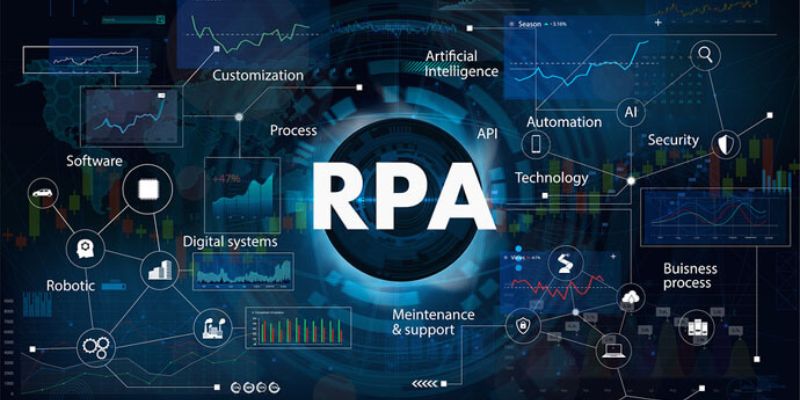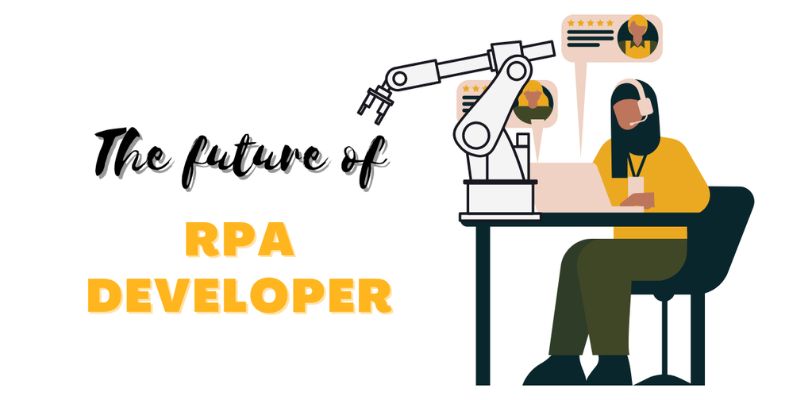How RPA is transforming business processes isn’t just a buzz-phrase; it’s the new norm. Imagine your daily grind, now picture it stripped of the dull, repetitive tasks that drain your time. That’s the reality companies are witnessing as they integrate robotic process automation (RPA) into their operations. This digital wizardry is not about replacing humans with robots; it’s about bolstering your team’s productivity. No more hours lost to manual data entry or mountains of paperwork. With RPA, businesses are hitting a stride in efficiency we once only dreamed of. Ready to dive into a world where your processes are streamlined like never before? Let’s unravel this game-changing tech and reveal what it holds for the future of business.
Unveiling the Potential of RPA in Modern Business
Exploring the Multifaceted Benefits of RPA in Business
Imagine a team that never sleeps, makes zero errors, and moves like lightning. That’s RPA, or robotic process automation, in a nutshell. This tech is changing how we work, bit by bit. It’s like a trusty sidekick for employees, taking over dull tasks so folks can focus on the big stuff.
RPA robots use software to handle repetitive work. Things like data entry, invoice processing, and even responding to simple customer queries. But it’s not just about the boring tasks. RPA can weave through complex workflows, too. It can make businesses run smoother and faster. We’re talking about serious gains in efficiency here.
Let’s say there’s a process that takes an hour each day. With RPA, it might take just minutes. This speed-up can happen in tons of industries, from banks working with RPA to speed up loan approvals to hospitals managing patient records with ease.
Understanding the Impact of Robotic Process Automation on Workflow Efficiency
Now, workflow is like a river. If there’s a block, things flood or dry up. RPA acts like an expert river guide. It helps the workflow stay swift and steady.
RPA is smart. It can spot issues and fix them fast. That means better service for customers and a happier team. With everything ticking along, businesses can do more without tripping over their own feet.
Think of a call center. RPA can pull up customer info in seconds. This means quick, helpful chats. Happy customers tell their friends. Those friends might just become new customers.
What’s more, using RPA means saying goodbye to mistakes. And mistakes can cost a ton. Not just in money, but in time and trust, too. By cutting errors, businesses save and build stronger bonds with customers.
Now, don’t think RPA is a one-size-fits-all. Every business is different. But that’s the beauty of RPA—it bends to fit unique needs. From a tiny shop to a massive corporation, RPA can scale up or down.
RPA can also hook up with other tech, like artificial intelligence. This duo can do even more, like understanding human talk to answer questions or predict what customers want. It’s like having a crystal ball that also does work!
In simple words, RPA is like a Swiss Army knife for businesses. It helps with cost savings, gets tasks done quick, and adapts as the business grows. For anyone in business, RPA is a game-changer. It’s here to stay, and it’s only getting smarter and more helpful. And staying ahead in the game is all about embracing these wonders of tech, like RPA, that make work a breeze.
Operational Agility and Efficiency through RPA Implementation
Real-World Applications of RPA Across Various Industries
Robotic Process Automation, or RPA, is a real game-changer. Think of it as a robot coworker that never gets tired. It’s amazing in banking. There, it speeds up account setups and credit checks. In healthcare, it helps with patient data and billing. This way, doctors have more time for care. Now picture a warehouse. The robot helps track packages fast so they ship out quicker. Customers love this!
For customer service, RPA is a star! It can pull up your info quick when you need help. No more waiting! Call centers use it to answer common questions. So, live agents can focus on the tougher stuff. And when it comes to HR, robots are the new helpers. They handle hiring paperwork and manage time-off requests.
RPA works day and night with zero errors. It’s like a perfect helper that makes sure everything runs smooth. Plus, it can learn and get better over time. This helps businesses stay ahead and keep customers happy.
How RPA is Re-engineering Business Processes for Competitive Advantage
By using RPA, companies change the rules. It’s all about doing more with less. Less money spent, less time wasted. With robots, tasks get done fast and right. This means businesses can serve more people in less time. It’s like having super-speed and super-accuracy, all in one.
Let’s talk about streamlining. RPA hunts down slow points in work. Then, it fixes them. This makes the whole process fly! It’s not just about cutting costs. RPA gives businesses a sharp edge. They can shift their focus to new ideas and grow.
And guess what? Robots give people a break from boring stuff. Instead, they can tackle big projects. They can dream up new ways to thrill customers. RPA isn’t just about saving money. It’s about making workplaces better for everyone.
When businesses scale with RPA, they move quicker than ever. They can take on new projects without breaking a sweat. It’s like opening the floodgates to growth and success. Staying ahead? RPA makes it possible.
From RPA in finance to robots in hospitals, the story is the same. Efficiency skyrockets. Plus, errors that bug us all? They drop like a rock. With RPA, companies are reimagining what’s possible. It’s not just a tech trend. It’s a business revolution that’s here to stay. And it’s transforming work in ways we only dreamed of.
So, think about it. An office where robots and humans team up. An office where work gets done better and faster. That’s the power of RPA – turning the everyday into something extraordinary.
Integrating RPA with AI: The Next Frontier in Business Automation
Enhancing RPA with Artificial Intelligence for Advanced Data Analytics
Robotic process automation, or RPA, is changing how we work. It takes over simple tasks we do on computers. It’s like having a robot helper that does boring work for us. We get extra time to work on more interesting things.
RPA is smart, but when we add artificial intelligence, or AI, it becomes even smarter. AI helps RPA understand things better, make decisions, and learn from mistakes. This mix of RPA and AI is powerful and exciting for businesses.
Think of AI as the brain and RPA as the hands. Together, they can do difficult jobs. They can look at lots of data and find patterns. Business leaders can use this to make better decisions.
With AI, the robots can read emails or chat messages and answer common questions. No need for people to do these tasks. This saves time and money.
By using AI, businesses can handle more work without errors. This is great for companies as they can help more customers and grow faster.
The Role of RPA in Achieving Operational Excellence and Cost Savings
RPA helps businesses work better and save money. By using RPA, they can do more with less. This means setting up robots to do jobs like entering data, making reports, and checking for mistakes. This can make work faster and more accurate.
Companies use RPA to make good changes. It helps them do better than their competitors. RPA is like a secret weapon for businesses to run smooth and fast. By using robots, companies can save money on things they needed people for before.
For example, banks use RPA to check loan applications quickly. This means customers get answers faster. And the bank saves money, because they don’t need as many people to look at the forms.
In healthcare, robots can help with organizing patient records. This means nurses and doctors can spend more time with patients. They don’t have to worry about paperwork as much.
RPA also helps in places like factories and stores. It can track what’s in stock and what needs to be ordered. This helps keep customers happy because they find what they need.
When companies use RPA, they do better. They save time and money. They can also make their customers happier. This is a big win for everyone.
As companies learn how to use RPA better, they can change the way they work. They can take small steps or go all in. The important part is to start using RPA to improve.
In the end, RPA doesn’t just change how we do tasks. It changes how businesses run for the better. It’s all about being smart and fast in a world that always changes. And that’s why RPA and AI together are the future of business.
Scaling Up with RPA: Strategies for Successful Deployment
Navigating the Trends and Challenges in RPA Adoption
Robotic Process Automation (RPA) is a big deal in business today. It’s a tool that adds speed and accuracy to work. By handling tedious tasks, it frees people to do more thinking jobs. This is key to making a company run better and grow. But there’s a catch. It’s not always easy to introduce RPA into a firm. Let’s talk about how to make it work well.
RPA uses software robots. They can learn and then do jobs that people used to do. This means they can quickly take over simple tasks. But why does this matter? We want our businesses to do more without spending more. RPA makes this possible. It is a game changer that moves us forward fast.
Sure, it’s not all smooth sailing. Keeping up with the fast move of RPA can be tough. Some folks worry about robots taking jobs. But the truth is, RPA makes jobs better. It lets people focus on more important work. This is a game changer. It makes businesses stronger. It also means happier workers.
Another worry is the cost. Yes, you need to spend money at first. But soon, you’ll see it pay off. Robots don’t sleep, get sick, or make mistakes. They work all the time. They also do work quickly and without fault.
Measuring the ROI of RPA and Ensuring Long-term Scalability
So, you’ve got robots working for you. But are they saving you money? To tell, you need to check out your return on investment (ROI). This shows how the cash you put into RPA is working for you. Is it making your processes quicker? Is it cutting down on errors? Ask these questions. They’ll help you know if RPA is the right move.
But what about when your business grows? Can RPA keep up? YES! That’s one of the best things about it. It slims down your processes. Less waste. More action. Robots can handle more work when needed. They can change with your needs. This is where you win. You set up RPA once, and it grows with you.
Now, let’s get real. To do RPA right takes planning. You have to pick the best tasks for it to do. Put robots where they’ll have the most impact. Teach your team about RPA. Make sure everyone knows how to use it in their job. This means less fear, more growth.
In the end, RPA is not just about robots. It’s about smarter work. It’s about taking full control of your business flows. RPA brings a beat to your work that wasn’t there before. It is steady and true. With the right steps, it leads you to a place of power in your market. It’s the helping hand in business we’ve all been waiting for. Use it well, and watch your enterprise prosper.
We dove into the power of Robotic Process Automation (RPA) and its game-changing role in businesses today. We explored its many benefits, like making work faster and less error-prone. We saw how it transforms tasks across all kinds of industries and creates an edge in the market.
Then, we looked at how RPA, teamed up with AI, paves the way for smarter business moves. It’s all about doing things better, faster, and saving money. Finally, we wrapped up with key strategies for making RPA work in the long run, and how to really tell if it’s paying off.
Here’s the bottom line: RPA isn’t just a fleeting trend – it’s a strong tool that, when used right, can take business operations to the next level. Let’s embrace the future, make the most of RPA, and watch businesses thrive!
Q&A :
How is RPA changing the landscape of business process management?
Robotic Process Automation (RPA) is revolutionizing business process management by allowing organizations to automate routine and mundane tasks with bots. This transformation leads to increased efficiency, faster turnaround times, and the elimination of human errors. RPA integration also liberates employees from repetitive work, empowering them to focus on more strategic, creative, and customer-focused initiatives.
What are the key benefits of implementing RPA in business processes?
The adoption of RPA in business processes provides multiple benefits, including:
- Cost Reduction: By automating tasks, businesses can significantly lower operational costs.
- Accuracy and Quality: Bots work with a high level of precision, reducing the likelihood of errors.
- Productivity: Automation enables 24/7 operation without fatigue, boosting overall productivity.
- Scalability: Companies can easily scale RPA solutions up or down to meet demand without the need for additional human labor.
- Compliance: Automated processes are consistent and can be programmed to adhere to regulatory requirements, ensuring compliance.
- Employee Satisfaction: Offloading repetitive tasks to bots can lead to increased job satisfaction for employees who can engage in more meaningful work.
What types of business processes are most suitable for RPA?
Processes that are ideal for RPA typically have the following characteristics:
- Rule-Based: Processes that operate on clear, straightforward rules can be easily codified for a bot.
- High Volume: Tasks that require handling large volumes of data or transactions are particularly suitable for automation.
- Repetitive Nature: Processes that are repetitive and prone to human error are excellent candidates for RPA.
- Digitally Accessible Data: Processes that use digital data enable bots to easily access and manipulate the required information.
- Stable and Well-Defined: Processes that don’t frequently change and are well documented make automation easier and more sustainable.
Can RPA integration be tailored for businesses of any size or industry?
Yes, RPA can be tailored to suit businesses of various sizes and industries. Whether it’s a small business looking to optimize a few key processes, or a large corporation aiming to transform multiple facets of operations, RPA can be customized to address specific needs and objectives. Different RPA tools and platforms offer a variety of features and scalability options that make them adaptable across sectors such as finance, healthcare, manufacturing, and customer service.
How does RPA differ from traditional IT automation?
RPA differs from traditional IT automation in that it is designed to be accessible to non-technical users, allowing processes to be automated by the people who understand them best: the process users. Traditional IT automation often requires significant programming skills and changes to underlying systems, whereas RPA bots can mimic human actions and interact with applications at the user interface level. This allows RPA to be more adaptive and less disruptive when automating tasks within existing business processes.






